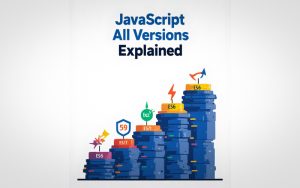
JavaScript (short for “Just Another Scripting Language”) is one of the most important and widely used programming languages in the world. It is mainly used to make websites more interactive and user-friendly. While HTML is used to structure a web page and CSS is used to style it, JavaScript adds life to the page by allowing features like sliders, pop-ups, drop-down menus, form validation, animations, and more.
JavaScript runs directly in the user’s web browser, which means it doesn’t need to be downloaded or installed separately. Most modern websites use JavaScript in some way to improve the user experience. It is supported by all major browsers like Chrome, Firefox, Safari, and Edge.
This language is also a core technology of web development, along with HTML and CSS. Over time, JavaScript has grown from a simple scripting language to a powerful tool that is now used not just on websites, but also in mobile apps, server-side applications, and even game development.
In short, JavaScript helps developers create dynamic and interactive content on the web, making websites smarter, faster, and more engaging for users.
Is JavaScript a Programming Language?

Yes, JavaScript is a programming language. It is one of the most widely used languages in the world, especially for building websites and web applications.
JavaScript is known as a scripting language, which means it helps websites do more than just show text and images. It makes websites interactive and dynamic. For example, when you see buttons that do something when clicked, forms that show messages, or images that move—JavaScript is usually behind all that.
JavaScript works together with HTML (which structures the content) and CSS (which styles the content). These three make up the core of modern web development.
In simple words, JavaScript helps turn a basic website into a smart and interactive one. It is also used in mobile apps, games, and even on servers through technologies like Node.js.
So yes, JavaScript is a powerful, flexible, and essential programming language for anyone who wants to build for the web.
What is JavaScript Commonly Used For?

JavaScript is one of the most widely used programming languages on the web. It is mainly used to make websites and apps more interactive, fast, and user-friendly. Below is a simple, clear explanation of what JavaScript is commonly used for, especially for beginners.
1. Making Websites Interactive
JavaScript brings websites to life. It helps websites respond to user actions like clicking a button, filling out a form, opening a menu, or changing content without refreshing the page. Without JavaScript, websites would be static and boring.
2. Building Web Applications
JavaScript is the backbone of many modern web applications such as Gmail, Facebook, and YouTube. These apps work smoothly in your browser without needing to reload every time you do something. JavaScript makes this possible by communicating with servers and updating the screen instantly.
3. Creating Mobile Apps
JavaScript is not just for websites — it’s also used to build mobile apps. Using frameworks like React Native, developers can create apps for both Android and iOS using the same JavaScript code.
4. Developing Desktop Applications
JavaScript can also be used to build desktop software. Tools like Electron allow developers to create apps like Skype, Slack, and Visual Studio Code — all powered by JavaScript.
5. Game Development
JavaScript is used to create browser-based games. These games run directly in the browser and don’t need to be downloaded. They are simple, fast, and fun to play.
6. Controlling Web Page Behavior
JavaScript controls things like animations, pop-ups, sliders, countdowns, and more. Anything on a webpage that moves, changes, or reacts when you interact with it is likely powered by JavaScript.
7. Building Server-Side Applications
JavaScript is not just limited to the browser. With tools like Node.js, developers can also use JavaScript to build powerful backend systems that handle data, users, and server logic.
How Does the JavaScript Code Work on Your Web Page?

JavaScript works on your web page by making it interactive and dynamic. When someone opens your web page, their web browser loads the HTML and CSS first, and then it reads the JavaScript code. This code tells the browser what actions to take, like showing a popup, changing text, or responding to a button click.
JavaScript runs directly in the user’s browser, not on the website’s server. This means that the code is downloaded with the web page and runs on the visitor’s device. It follows a top-to-bottom order, so the browser reads and executes it step by step. If any part of the code is not written correctly or tries to use something that hasn’t been defined yet, the browser will show an error.
In short, JavaScript adds smart behavior to your web page by running in the browser and reacting to the user’s actions.
JavaScript All Versions Explained

JavaScript is a powerful programming language used to make websites interactive. Over time, it has gone through many updates. Each new version added useful features to make coding easier, faster, and more secure. Here’s a simple explanation of all major JavaScript versions in plain English:
1. JavaScript (ES1 to ES5): The Early Days
- ES1 to ES3 (1997–1999): These were the very first versions. They introduced the basic features like variables, loops, and simple functions.
- ES4 (Skipped): This version was planned but never released due to disagreements.
- ES5 (2009): This was a big step forward. It added features like:
- Better error handling
- JSON support
- New array methods
This version became the foundation for modern JavaScript.
2. ES6 (2015) – The Modern JavaScript
Also called ECMAScript 2015, this version was a game-changer. It introduced many new features to make code cleaner and easier to write, such as:
- let and const for better variable control
- Arrow functions (shorter ways to write functions)
- Classes and modules
- Promises for easier asynchronous programming
It made JavaScript more powerful and beginner-friendly.
3. ES7 to ES13 (2016–2022): Small But Smart Updates
Each year, new versions came with useful improvements:
- ES7 (2016): Added includes() method and exponentiation operator
-
- ES8 (2017): Introduced async/await for better handling of async code
- ES9 (2018): Improved regular expressions and added spread/rest operators for objects
- ES10 (2019): Brought in flat array methods and optional catch binding
- ES11 (2020): Added optional chaining (?.) and nullish coalescing (??)
-
- ES12 (2021): Introduced logical assignment and numeric separators
- ES13 (2022): Improved class features and added top-level await
These updates made JavaScript more readable and easier for developers.
4. ES14 (2023) and Beyond
New versions continue to improve JavaScript:
- More control for developers
- Better performance
- Cleaner syntax
JavaScript is always evolving to keep up with modern web needs.
Which version of JavaScript is used in today?

The version of JavaScript used today is the latest ECMAScript standard, currently ES14 (ECMAScript 2023). However, most websites and applications use features from ES6 (2015) and newer, because modern browsers fully support them.
JavaScript updates every year, but not every project uses the very newest features right away. Still, all major browsers—like Chrome, Firefox, Safari, and Edge—keep up with the latest standards, so developers can safely use modern JavaScript features in their websites.
Conclusion:
JavaScript is one of the most important programming language for building modern websites and apps. It makes websites interactive, dynamic, and user-friendly. While HTML gives structure and CSS gives style, JavaScript brings websites to life with features like animations, pop-ups, forms, buttons, and more.
Today, JavaScript is not just used in websites. It is also used for mobile apps, desktop apps, games, and even on servers. Over the years, JavaScript has improved with new versions like ES6 and ES14, adding powerful features that make it easier for developers to write better code.
FAQ
1: What is JavaScript?
JavaScript is a popular programming language used to make websites interactive and dynamic. While HTML builds the structure and CSS adds style, JavaScript adds life to a website. It allows things like button clicks, pop-ups, form validation, animations, and real-time updates. JavaScript runs directly in the browser and works on all major websites.
- What is the difference between JavaScript and HTML/CSS?
HTML creates the structure of a webpage, CSS adds styles (like colors and layout), and JavaScript adds interactivity. All three work together to build modern websites.
3: Can JavaScript run without the internet?
A: Yes, JavaScript can run without the internet. Since it works directly in your web browser, you can write and test JavaScript on your local computer using simple files. You don’t need to be online unless your code is trying to load data from the internet or a server. This makes JavaScript great for practicing offline.

